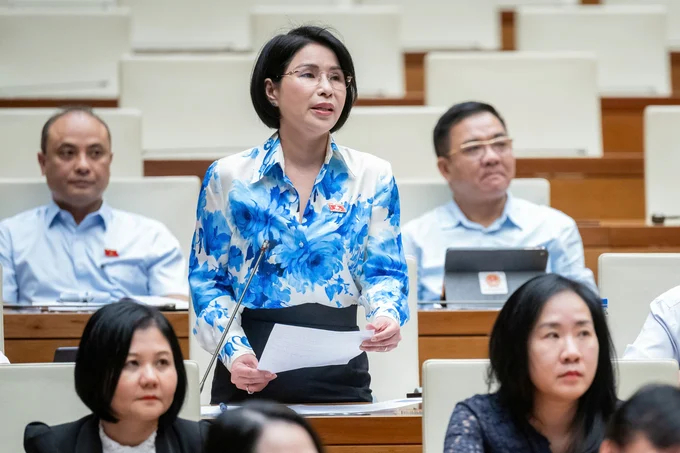November 28, 2025 | 02:36 GMT +7
November 28, 2025 | 02:36 GMT +7
Hotline: 0913.378.918
November 28, 2025 | 02:36 GMT +7
Hotline: 0913.378.918

Delegate Tran Thi Nhi Ha (Hanoi) asked about the difficulties in lobbying the European Commission to remove the "yellow card" on seafood for Vietnam. Photo: National Assembly.
Questioning the Minister of Agriculture and Rural Development, delegate Tran Thi Nhi Ha (Hanoi) said that in 2024, our country's seafood industry will continue to face many challenges from the market, from selling prices to challenges due to trade barriers. Especially in the context that Vietnam has been warned with a yellow card by the European Commission (EC) for nearly 7 years on seafood activities.
Therefore, the delegate asked the Minister to let him know what difficulties and obstacles the Ministry is currently facing in the process of lobbying the European Commission to remove the yellow card on fisheries for Vietnam.
Responding to delegates about solutions to remove the IUU "yellow card," Minister Le Minh Hoan said that the main solution is still to effectively implement the Vietnam Fisheries Development Strategy to 2030, with a vision to 2045; the Sustainable Agricultural and Rural Development Strategy for the 2021-2030 period, with a vision to 2050, approved by the Prime Minister.
In this framework, fisheries development is based on three pillars: reducing exploitation, increasing aquaculture, and marine conservation, which ensure fishery reserves for future generations.
Minister Le Minh Hoan stated that the solutions to remove the IUU yellow card that we have implemented over the past seven years have had certain results. We have also reorganized the fisheries control system; currently, all 28 coastal localities have fisheries control forces; and we have a Resolution of the Supreme People's Court's Judicial Council on criminalizing violations related to IUU.
Although the number of vessels has been reduced by 20,000 (from over 100,000 to 86,000), Vietnam still has an excessively large fleet compared to other countries in the region, which poses a significant challenge to sustainable development.
In the coming period, we must continue demonstrating Vietnam's commitment to addressing the IUU yellow card issue. This will involve close coordination with the Ministry of Foreign Affairs, the Ministry of Public Security, and the Ministry of National Defense, particularly during the peak enforcement month.
However, Vietnam’s fisheries industry remains fragmented, characterized by small-scale and disjointed operations. Moreover, there is a lack of institutions to enforce community-based management of aquatic resources, an approach that is already mandated by law.
The Minister also noted that human resource development within the fishing industry remains inadequate. Therefore, in the future, the Ministry will collaborate with the Ministry of Education and Training to develop solutions aimed at raising awareness among fishermen about the importance of protecting aquatic resources.
Translated by Quynh Chi

(VAN) On November 27, in the meeting with Minister Tran Duc Thang, Mayor Yin Yong shared Beijing’s experience to improve environment and air quality.

(VAN) After 30 years, both sides identified strategic areas of cooperation: sustainable production, increasing coffee value and training for farmers.
/2025/11/27/4910-4-164708_294.jpg)
(VAN) On the afternoon of November 27 in Beijing, Minister of Agriculture and Environment Tran Duc Thang held a working session with several major Chinese enterprises operating in the agriculture and environment sector.

(VAN) The Department of Animal Health issued a provisional guideline requesting local authorities to increase surveillance, collect samples for testing, and conduct epidemiological investigations according to the established procedure.

(VAN) The United Nations recommends that Vietnam utilize data and artificial intelligence to enhance early disaster warnings and reduce GDP losses by 3.2% in the context of climate change.

(VAN) On the morning of November 27 in Beijing, Minister Tran Duc Thang and the Deputy Commissioner General of the General Administration of Customs of China signed a protocol on fresh jackfruit exports.

(VAN) As floodwaters recede, a vast network of irrigation works across eastern Gia Lai is emerging in a state of severe disrepair, with extensive damage demanding urgent restoration ahead of the 2025-2026 winter-spring cropping season.